The overall fisheries production in Ilocos Region grew by 14.3 percent in 1st quarter 2019. From the total output of 30,021 metric tons in 1st quarter 2018, it went up to 34,299 metric tons this year. All the provinces, except La Union, recorded higher output.
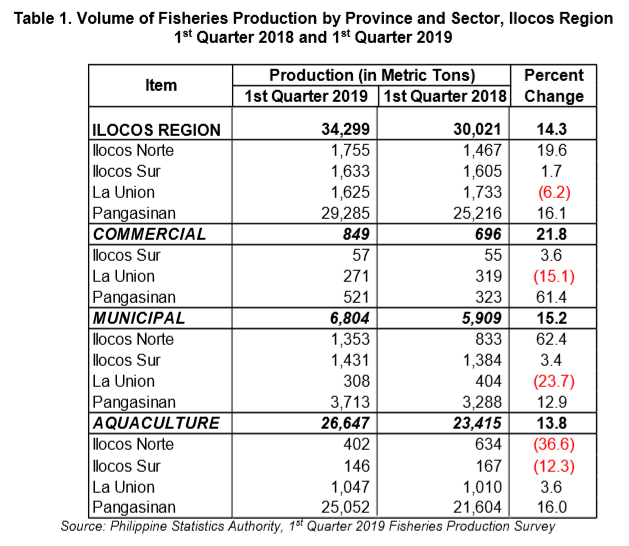
All the three sub-sectors registered higher production in 1st quarter 2019 compared with their levels a year ago. The aquaculture contributed 77.7 percent to the total fisheries output. The municipal and commercial fisheries accounted for 19.8 percent and 2.5 percent of the total fisheries output, respectively.
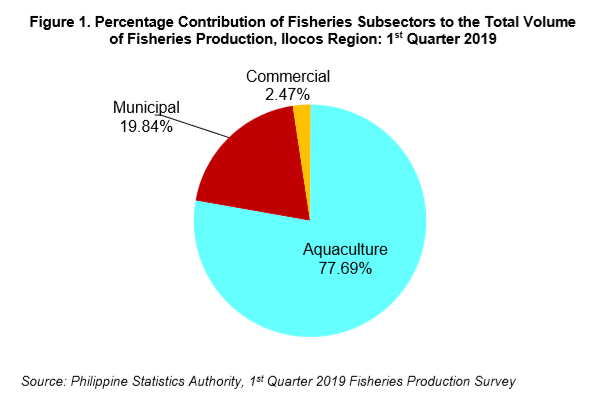
In terms of provincial distribution, the province of Pangasinan shared the bulk of production in the region of about 85.4 percent. The overall volume of production of the province was posted at 29,285 metric tons, or 16.1 percent higher than its production in the same period of 2018. All the three fisheries subsectors realized positive growth in output. The commercial and municipal subsectors increased by 61.4 percent and 12.9 percent, respectively, while the aquaculture grew by 16.0 percent.
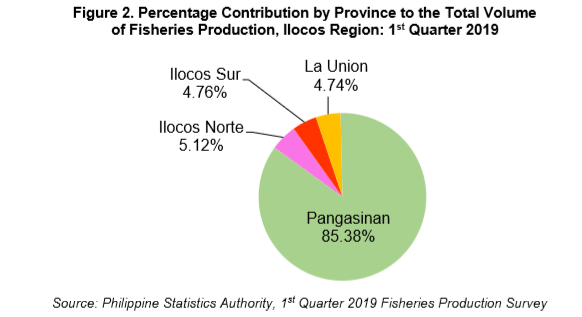
Ilocos Norte distantly followed Pangasinan with a 5.1 percent share to the total volume of production in the region. Its fisheries production went up by 19.6 percent in 1st quarter 2019 with an output of 1,755 metric tons from an output of 1,467 metric tons in 1st quarter 2018. The municipal subsector, which shared the bulk of output, contributed to the overall positive performance of the province in terms of fisheries production.
Meanwhile, Ilocos Sur with a 4.8 percent share to the total volume of production in the region was third highest in 1st quarter 2019. The fisheries production of Ilocos Sur was recorded at 1,633 metric tons in 1st quarter 2019, higher by 1.7 percent than the production a year ago of 1,605 metric tons. Increased catch in the commercial and municipal subsectors, which grew by 3.6 percent and 3.4 percent, respectively, contributed to the overall increment in output.
The province of La Union, which had the least percent share of about 4.7 percent to the total fisheries production of Region I, recorded lower fisheries production in 1st quarter 2019 compared with its level a year ago. From 1,733 metric tons production, it went down to 1,625 metric tons attributed to the decline in the output of the commercial and municipal sub-sectors.
Commercial Fisheries
The commercial fisheries volume of production in Ilocos Region posted at 849 metric tons in 1st quarter 2019. The output was higher than its level in 1st quarter 2018 of 696 metric tons. The provinces of Pangasinan and Ilocos Sur contributed to the improved performance of the subsector. Presence of school of fish and more catch from payaos were the factors that might contributed to the positive growth.
In terms of provincial shares, Pangasinan accounted for 61.4 percent of the region’s commercial fisheries volume of production in 1st quarter 2019. La Union followed with 31.9 percent share and Ilocos Sur with 6.7 percent share.
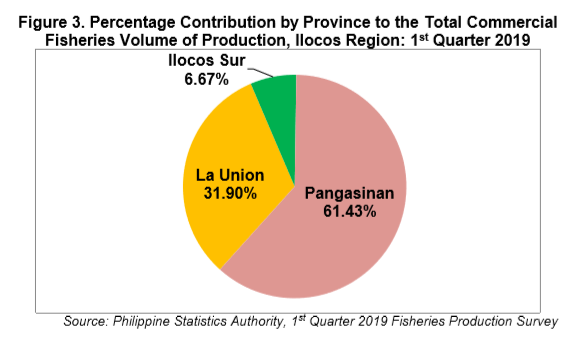
The top five major catch in the region during the 1st quarter 2019 were Roundscad, Skipjack, Threadfin bream, Indian mackerel, and Indo-pacific mackerel.

Municipal Fisheries
The overall municipal fisheries production of Ilocos Region grew by 15.1 percent in 1st quarter 2019. The production was posted at 6,804 metric tons, higher than the output in 1st quarter 2018 of 5,909 metric tons. The increased catch in marine municipal fisheries contributed to the overall positive performance of the subsector.
Marine Municipal
Production of Marine Municipal Fisheries in Ilocos Region also grew in 1st quarter 2019. Its output was posted at 6,548 metric tons, 19.9 percent higher than the output a year ago of 5,462 metric tons. All the provinces of the region, except La Union, contributed to the overall increment in output. More fishing days were recorded due to shorter duration and effect of northeast monsoon and tail end of cold front. Presence of school of fish, and more harvest from payaos and artificial reeds were also noted.
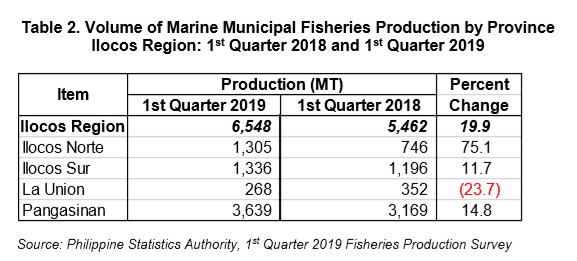
The province of Pangasinan contributed 55.6 percent to the region’s marine municipal fish catch for the 1st quarter 2019. It was followed by Ilocos Sur with 20.4 percent share, Ilocos Norte with 19.9 percent share, and La Union with 4.1 percent share.
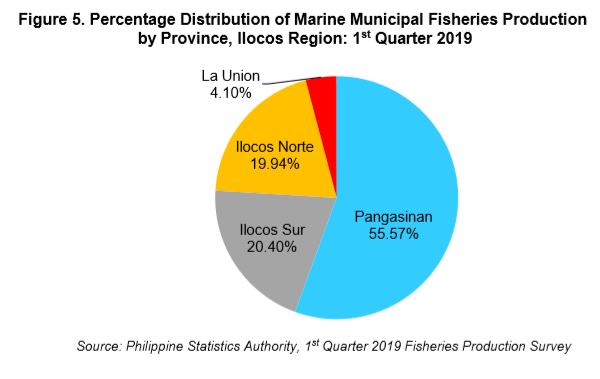
The dominant catch in marine municipal waters of Ilocos Region during the period were Squid, Yellowfin tuna, Cavalla, Grouper, and Skipjack.
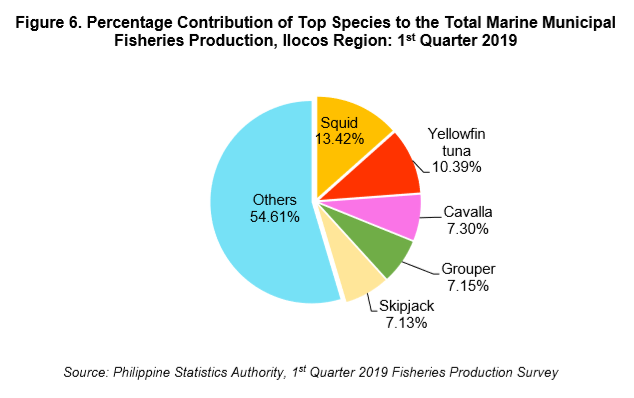
Inland Municipal Fisheries
Production of Inland Municipal Fisheries in Ilocos Region declined by 42.7 percent in 1st quarter 2019. From the output of 447 metric tons in the same period last year, it went down to 256 metric tons this year. All the provinces of the region posted lower production. Lesser fish shelters and corrals were set due to lower water level in rivers, coupled with lesser appearances and smaller sizes of catch. Lesser fishing operations were also noted as some fishing households focused on marine fishing and aquaculture operations, construction works, and harvesting of palay.
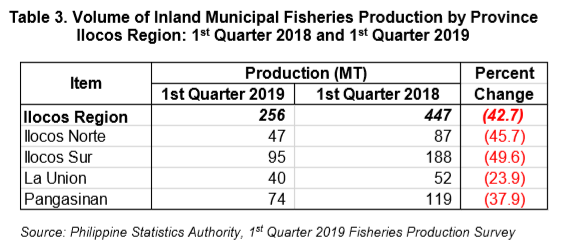
By province, Ilocos Sur ranked first in volume of production of Inland municipal fisheries during the 1st quarter 2019 with 37.1 percent share. Pangasinan followed with 28.9 percent share, Ilocos Norte with 18.4 percent share, and La Union with 15.6 percent share.
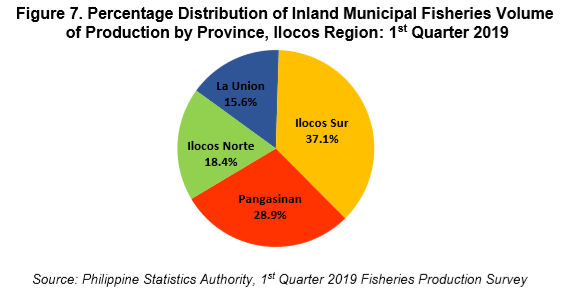
The top five major catch in the region during the period were Tilapia, Freshwater goby, Freshwater crab, Mullet and Carp.

Aquaculture
Aquaculture production of Ilocos Region posted a production of 26,645 metric tons in 1st quarter 2019, higher by 13.8 percent than the production in 1st quarter 2018 of 23,415 metric tons. Early harvesting was made to avoid losses caused by decreased water leveI and isolated fish kill. There was also increased stocking rate due to availability of fingerlings. The provinces of Pangasinan and La Union posted positive growth in their outputs.
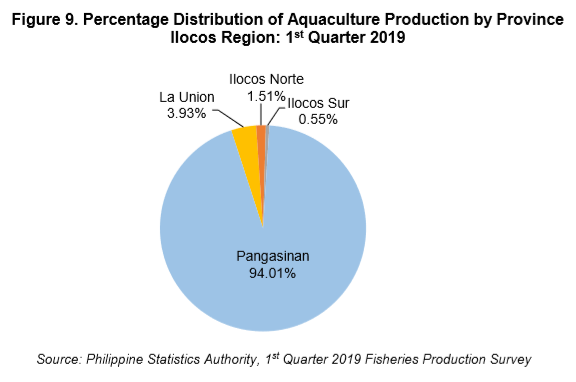
The province of Pangasinan shared the bulk of aquaculture production in 1st quarter 2019 with 94.0 percent share. By culture type, aquaculture in Ilocos Region dominated by Marine Cage which accounted for 63.5 percent of the total production.
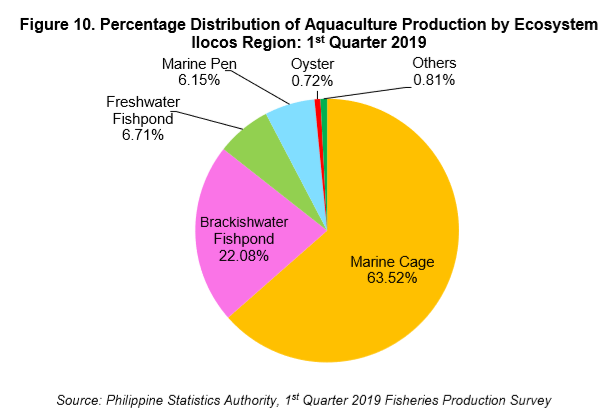
Milkfish dominated the aquaculture production of Ilocos Region with a share of 90.1 percent. Its production in 1st quarter 2019 was registered at 20,004 metric tons, higher than its output in the same quarter last year of 20,666 metric tons. Early harvesting was made due to lower water level in some farms, and incidence of isolated fish kill. Bulk of milkfish production came from the province of Pangasinan.
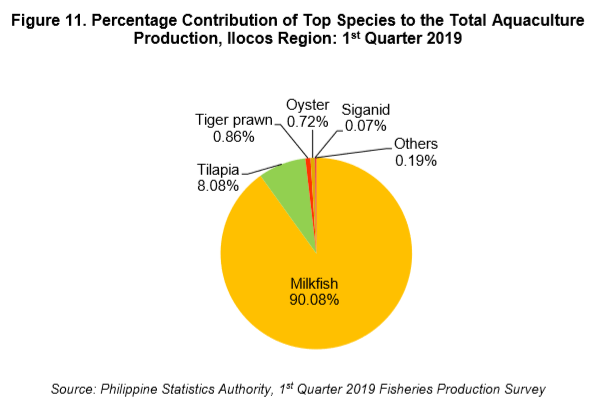
TECHNICAL NOTES
The Fisheries Production Survey of the Philippine Statistics Authority (PSA) is divided into four major fisheries surveys. These are the Quarterly Commercial Fisheries Survey (QCFS), Quarterly Municipal Fisheries Survey (QMFS), Quarterly Inland Fisheries Survey (QIFS) and Quarterly Aquaculture Survey (QAqS). The commercial and municipal fisheries surveys aim to provide quarterly data on volume and value of fish production by species, by region, and by province. The aquaculture survey is intended to generate quarterly data on volume and value of cultured species by environment, by type of aquafarm, by region, and by province.
Concepts and Definitions:
Aquaculture – fishery operation involving all forms of raising and culturing of fish and other fishery species in marine, brackish and freshwater environment. Examples are fishponds, fish pens, fish cages, mussel, oyster, seaweed farms and hatcheries.
Aquafarm – the farming facilities used in the culture or propagation of aquatic species including fish, mollusk, crustaceans, and aquatic plants for purposes of rearing to enhance production.
Brackishwater – mixture of seawater and freshwater with salinity that varies with the tide. Example are estuaries, mangroves, and mouths of rivers where seawater enters during high tide.
Commercial Fishing – the catching of fish with the use of fishing boats with a capacity of more than three (3) gross tons for trade, business or profit beyond subsistence or sports fishing.
Fisheries – all activities relating to the act or business of fishing, culturing, preserving, processing, marketing, developing, conserving and managing aquatic resources and the fishery areas including the privilege to fish or take aquatic resources thereof (RA 8550).
Fisheries Sector – the sector engaged in the production, growing, harvesting, processing, marketing, developing, conserving and managing aquatic resources and fishing areas.
Fish Cage – stationary or floating fish enclosure made of synthetic net wire/bamboo screen or other materials set in the form of an inverted mosquito net (“hapa” type) with or without cover with all sides either tied to poles staked to the water bottom or with anchored floats for aquaculture purposes.
Fishing Gear – any instrument or device and its accessories utilized in taking fish and other fishery species.
Fishing Grounds – areas in any body of water where fish and other aquatic resources congregate and become the target of capture.
Fish Pen – an artificial enclosure constructed within a body of water for culturing fish and fishery/ aquatic resources made up of bamboo poles closely arranged in an enclosure with wooden materials, screen or nylon netting to prevent an escape of fish.
Fishpond – a body of water (artificial or natural) where fish and other aquatic products are cultured, raised or cultivated under controlled conditions. This is a land-based type of aquafarm. Note that the setting-up of fish cages in ponds does not make the operation of a fish cage and at the same time a fishpond.
Freshwater – water without salt or marine origins, such as generally found in lakes, rivers, canals, dams, reservoirs, paddy fields, and swamps.
Inland Municipal Fishing – the catching of fish, crustaceans, mollusks and all other aquatic animals and plants in inland water like lakes, rivers, dams, marshes, etc. using simple gears and fishing boats some of which are non-motorized with a capacity of three gross tons or less; or fishing not requiring the use of fishing boats.
Landing Center – a place where the fish catch and other aquatic products are unloaded and traded.
Municipal Fishing – covers fishing operation carried out with or without the use of a boat weighing three gross tons or less.
ATTY. SHEILA O. DE GUZMAN
(Chief Administrative Officer)
Office-in-Charge

